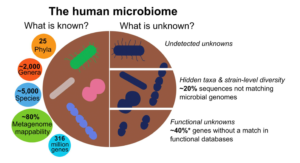Prebiotics are a type of fiber that the human body cannot digest. Prebiotics are mostly fermentable carbohydrates which pass into the lower digestive tract and serve as a food source for gut microbiota, acting as nutrients to help them grow. So, with the proper amount of prebiotics in the body, people can optimize the work of the good bacteria that promotes gut health.
As a matter of fact, prebiotics serve as food for probiotics, which are tiny living microorganisms, including bacteria and yeast. Prebiotics may support helpful bacteria and other organisms in the gut and allows your gut microbiota to produce nutrients like short chain fatty acids which leads to a healthier digestive system. Prebiotics also may help with allergy prevention and symptoms of eczema by impacting directly and indirectly on the systems involved in allergic disease development. Studies suggest that eating 3 to 5 grams of prebiotics a day can benefit the health of your gut.
The examples of common prebiotics
- Fructo-oligosaccharides (FOS)
- Galacto-oligosaccharides (GOS)
- Resistant starches
- Pectic oligosaccharides (POS)
- Inulin
- Non-carbohydrate oligosaccharides
- Polyphenols
- Some fatty acids
The Best Prebiotic Sources
Prebiotics occur naturally in some high-fiber foods but are sometimes added to foods. They are also available as a dietary supplement.
Some of the best prebiotic foods are: Onion, Chicory root, Dandelion greens, Jerusalem artichoke, Garlic, Legumes, Leeks, Asparagus, Bananas, Barley, Oats, Corn, Soybeans, Lentils, Red kidney beans, Almonds and almond skins, Fermented dairy products (such as yogurt, buttermilk and kefir), Heated milk (at least 149 °F), Breast milk, and Foods that prebiotics may be added to.








